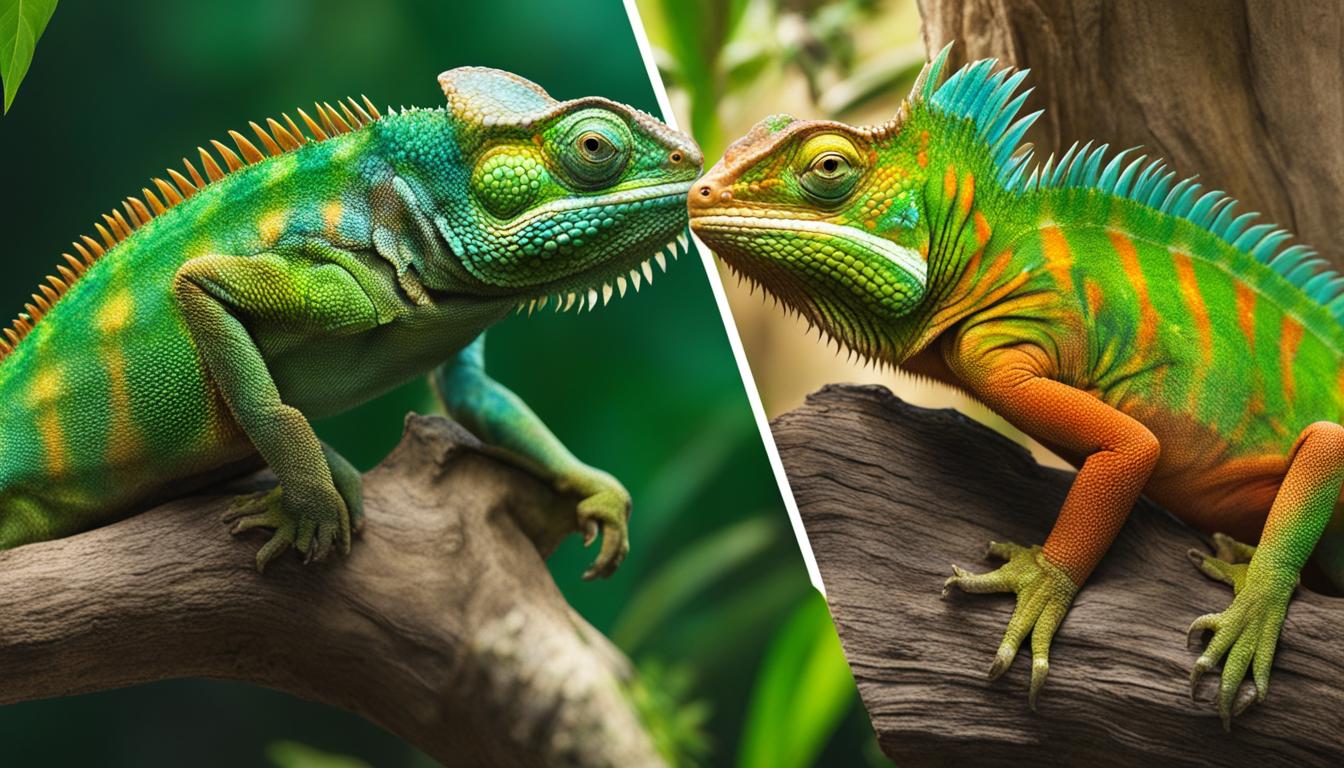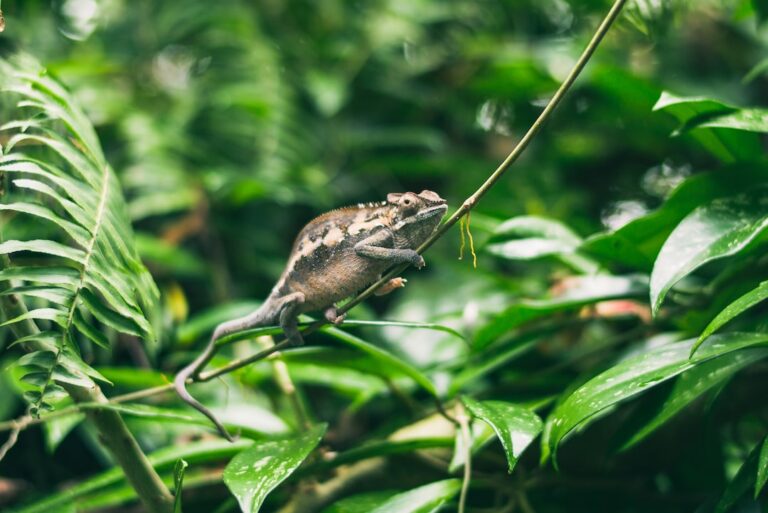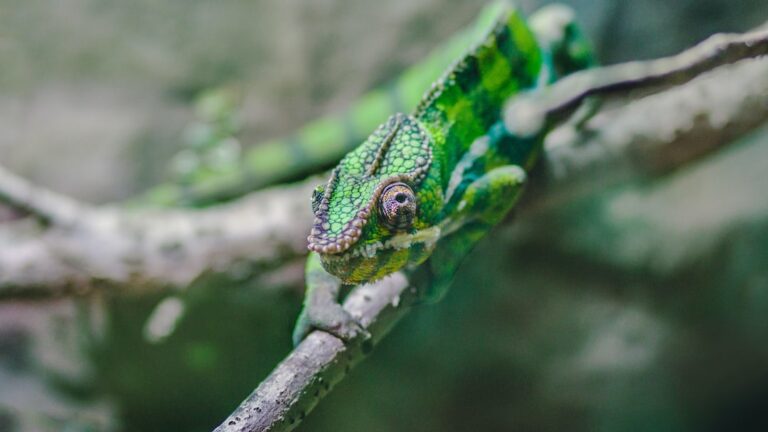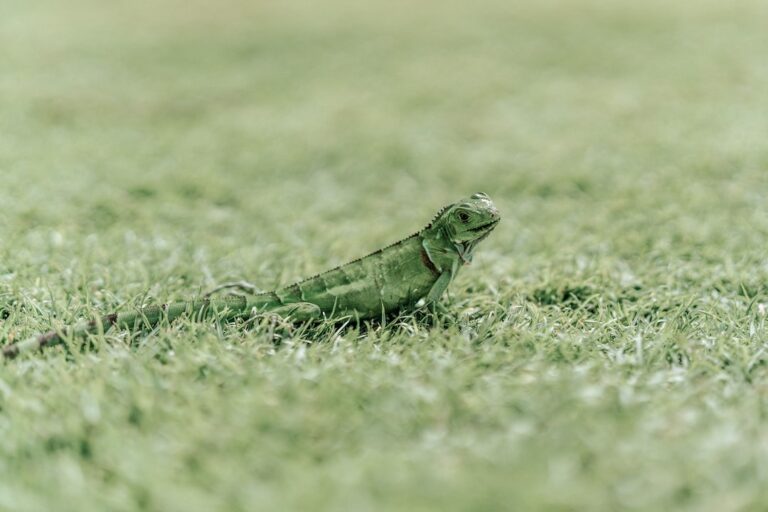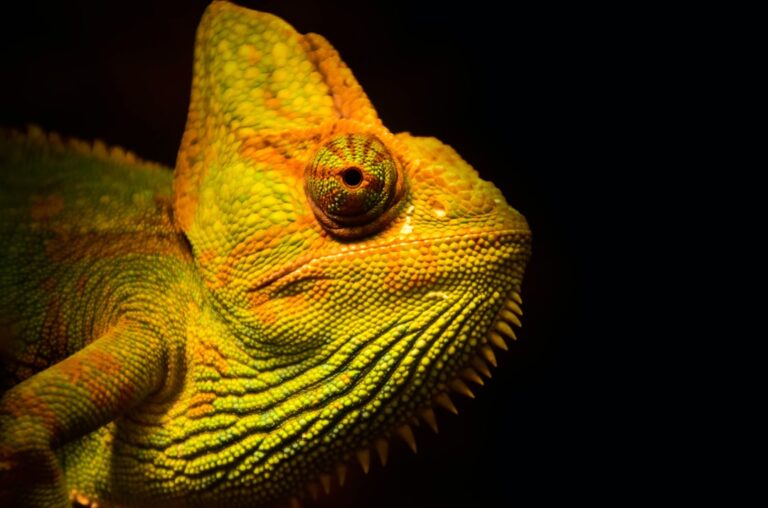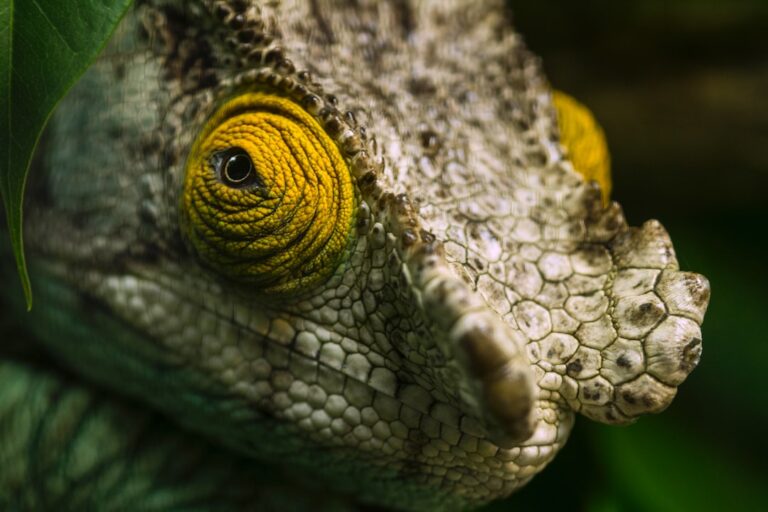Chameleon vs Iguana: Understanding The Key Differences
Chameleons and iguanas are both fascinating reptiles that captivate the hearts of many pet owners. However, it’s important to recognize that these two species have distinct differences that set them apart. In this article, we will delve into the contrasting characteristics of chameleons and iguanas, shedding light on their unique traits and care requirements.
Table of Contents
Key Takeaways:
- Chameleons and iguanas are both reptiles, but they differ in terms of diet, size, habitat, and interactivity.
- Iguanas are herbivores and primarily consume a plant-based diet, while chameleons are carnivores, relying on insects as their main source of nutrition.
- Chameleons are known for their extraordinary ability to change color, blending seamlessly into their surroundings, whereas iguanas possess spiny crests and a unique third eye on top of their heads.
- When it comes to size, chameleons are generally smaller, ranging from 0.6 to 27 inches in length, whereas iguanas can grow up to 6 feet, including their tails.
- Chameleons are arboreal, preferring a life in the trees, while iguanas spend most of their time in the treetops but can also venture onto the ground.
- While chameleons are more timid and should be observed rather than handled, iguanas can become sociable through regular socialization and interaction with humans.
- Proper care for both chameleons and iguanas requires specialized enclosures, heating, lighting, and attention to dietary needs.
Size and Morphology of the Body
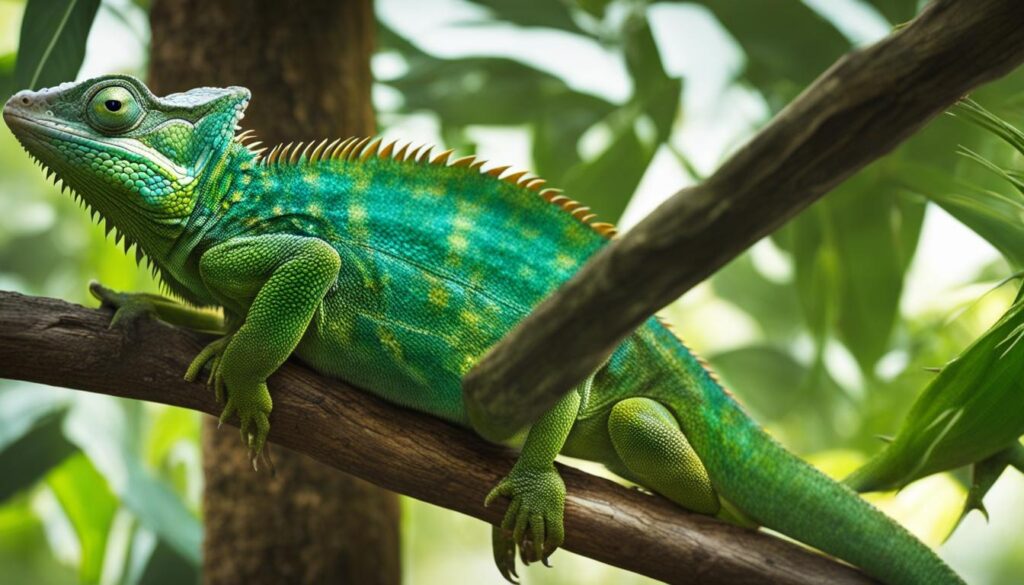
When comparing chameleons and iguanas, one of the key differences lies in their size and morphology. Chameleons are generally smaller in size, ranging from 0.6 to 27 inches in length. They have a unique body structure, with a laterally compressed body, long tail, and a sticky tongue used to capture prey. Some chameleons also have crests on top of their heads, adding to their distinctive appearance.
On the other hand, iguanas are larger reptiles, with lengths ranging from 4 to 6 feet, including their tails. They have a more robust and muscular body structure compared to chameleons. In addition to their size, iguanas possess spiny crests along their backs and a light-sensing organ called the third eye on top of their heads. They also have a dewlap, a flap of skin located beneath their necks that they use for communication and mating displays.
Overall, chameleons and iguanas exhibit contrasting size and morphology, with chameleons being smaller and having unique body features, while iguanas are larger and possess distinct physical characteristics.
| Chameleons | Iguanas |
|---|---|
| Size: 0.6 to 27 inches in length | Size: 4 to 6 feet in length, including tail |
| Morphology: Laterally compressed body, long tail, sticky tongue | Morphology: Robust body, spiny crests, third eye, dewlap |
Diet
One of the key differences between chameleons and iguanas is their diet. Chameleons are carnivores and primarily eat insects. Their diet consists of a variety of small insects such as crickets, mealworms, and waxworms. Larger chameleons may even hunt and consume small lizards and birds. It’s important for chameleons to have a varied diet to ensure they receive all the necessary nutrients.
On the other hand, iguanas are herbivores and have a diet primarily composed of fruits, flowers, shoots, and leaves. They require a diet rich in calcium and vitamin D3. It’s crucial for iguanas to have a well-balanced diet to prevent health issues like metabolic bone disease.
Overall, chameleons need a diet rich in insects, while iguanas need a diet consisting of plant-based foods. It’s important for owners to provide the appropriate food for each species to ensure their nutritional needs are met.
| Chameleons | Iguanas |
|---|---|
| Carnivores | Herbivores |
| Feed on insects like crickets, mealworms, and waxworms | Consume fruits, flowers, shoots, and leaves |
| Require a varied diet to meet nutritional needs | Need a well-balanced diet rich in calcium and vitamin D3 |
Chameleon and Iguana Lifestyles: Exploring the Reptilian World
Chameleons and iguanas, both fascinating reptiles, have distinct lifestyles that reflect their unique adaptations and habitats. Chameleons, known for their remarkable color-changing abilities, are primarily arboreal creatures. They spend most of their lives in trees, utilizing their specialized feet and tails to grip branches with ease. On the other hand, while iguanas can also climb trees, they are generally larger than chameleons and tend to spend more time in the treetops. These large lizards have adapted to their surroundings, possessing strong limbs and claws that aid in their arboreal lifestyle.
Both chameleons and iguanas are well-suited to their reptilian existence. Chameleons’ ability to change color allows them to camouflage and blend into their surroundings, providing an effective defense mechanism against predators. In contrast, iguanas rely on their size and spiny crests to deter potential threats. While chameleons are relatively more reserved and prefer to be observed rather than handled, iguanas can exhibit sociable behavior through regular and careful socialization. Their personalities evolve as they grow, with younger iguanas being more active and adults becoming more docile.
To gain further insight into the different lifestyles of chameleons and iguanas, let’s take a closer look at their physical characteristics:
| Chameleons | Iguanas | |
|---|---|---|
| Body Size | Varies from 0.6 to 27 inches | Can grow up to 6 feet |
| Tail | Long and slender | Includes the tail, reaching lengths of 4 to 6 feet |
| Feet | Specialized for climbing and gripping branches | Strong limbs and claws for arboreal locomotion |
Understanding the lifestyles of chameleons and iguanas is crucial when considering them as pets. While chameleons require a vertically spacious enclosure with ample foliage and branches to mimic their natural habitat, iguanas demand even more space due to their larger size. The care requirements for both reptiles differ significantly, making it essential for potential owners to research and prepare adequately to meet their specific needs.
Health & Care
Proper health and care for chameleons and iguanas is essential to ensure their well-being. Chameleons require a lot of space in their enclosure, as they are arboreal creatures that need vertical climbing opportunities. It’s important to provide them with plenty of foliage, branches, and hiding spots to mimic their natural habitat. Additionally, chameleons need a basking area with a heat source to regulate their body temperature.
Chameleons also require specific lighting, including UVA/UVB exposure, to support their physical and mental health. This can be achieved through specialized UVB bulbs or natural sunlight exposure. It’s crucial to monitor these parameters closely to prevent issues such as metabolic bone disease.
Iguanas, on the other hand, require different levels of care. They are larger lizards that need a spacious enclosure with both vertical and horizontal space to move around. Heat and humidity levels should be monitored and maintained consistently. Proper heating sources, such as heat lamps or ceramic heat emitters, should be provided.
Additionally, iguanas have specific dietary requirements as herbivores. Their diet should consist of a variety of fresh fruits, vegetables, and leafy greens. It’s important to avoid feeding them high-protein or fatty foods, as this can lead to health issues. Calcium supplementation is also crucial for their bone health.
| Chameleons | Iguanas |
|---|---|
| Require a spacious enclosure with vertical climbing opportunities | Need a large enclosure with both vertical and horizontal space |
| Require a basking area and specific lighting, including UVA/UVB exposure | Need consistent heat and humidity levels, provided through appropriate heating sources |
| Primarily eat insects and may require calcium supplementation | Have a herbivorous diet consisting of fresh fruits, vegetables, and leafy greens |
Personality & Interaction
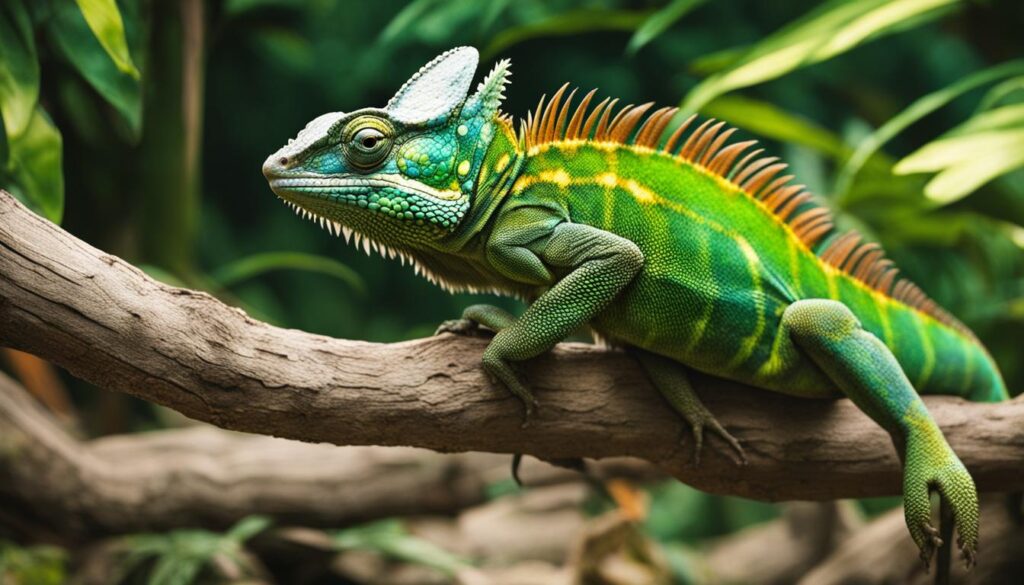
When it comes to personality, chameleons and iguanas display distinct traits due to their nature as reptiles. Chameleons are known for their timid and shy behavior, preferring to be observed rather than handled. Their ability to change color serves as a defense mechanism, allowing them to blend into their surroundings and avoid predators. Chameleons are relatively solitary creatures, and they may become stressed if handled too frequently. Therefore, it’s recommended to limit handling to only when necessary, such as for veterinary care or enclosure maintenance.
In contrast, iguanas have a more sociable disposition and can become comfortable with regular human interaction when properly socialized. They may enjoy being handled and can form bonds with their owners. However, it’s important to note that their size and strength should be taken into consideration, especially as they grow larger. Younger iguanas tend to be more active and may require more supervision and stimulation, while adult iguanas tend to become more docile.
It’s crucial to respect the natural behaviors and needs of both chameleons and iguanas to ensure their well-being and minimize stress. Understanding their personalities and interaction preferences can help reptile enthusiasts make an informed choice when considering them as pets.
Lifespan
Knowing the lifespan of chameleons and iguanas is essential for those considering them as pets. Chameleons typically have a lifespan of 3 to 10 years, depending on the species and the care provided. On the other hand, iguanas can live much longer, with some individuals reaching up to 20 years with proper care and attention.
Chameleons may have a shorter lifespan compared to iguanas due to their specific needs and delicate nature. They require a carefully maintained habitat with adequate lighting, temperature, and humidity. Meeting these requirements is crucial for their overall health and longevity.
Iguanas, on the other hand, can live longer if their specific needs are met. They require a spacious enclosure, proper heating, and a strict herbivorous diet. Providing an environment that mimics their natural habitat is essential for their well-being and longevity.
It’s important to note that the lifespan of both chameleons and iguanas can be influenced by various factors, including genetics, nutrition, and overall care. By providing the necessary care and attention, owners can help ensure their pet reptiles live long, healthy lives.
Which Breed is Right For You?
Choosing between an iguana and a chameleon can be a challenging decision. Both reptiles have unique qualities and care requirements that need to be considered. To help you make an informed choice, let’s take a closer look at the factors you should consider when deciding which pet is the best fit for you.
Key Factors to Consider
When deciding between an iguana or a chameleon, there are several key factors to consider:
- Size: Iguanas are generally larger than chameleons, requiring more space in terms of both enclosure size and living area.
- Care Requirements: Chameleons have specific habitat requirements, such as temperature, humidity, and lighting, which need to be closely monitored. Iguanas also have specific needs, including a herbivorous diet and proper heating.
- Handling: Chameleons are delicate and generally not recommended for handling, while iguanas can become comfortable with regular socialization.
- Interaction: Chameleons are known for their color-changing abilities and mesmerizing eyes, making them captivating pets to observe. Iguanas, on the other hand, can be sociable and enjoy human attention.
By considering these factors, you can determine which pet aligns best with your preferences, capabilities, and available space.
A Complete Comparison
To further illustrate the differences between iguanas and chameleons, let’s take a look at a detailed comparison:
| Factor | Chameleon | Iguana |
|---|---|---|
| Size | 0.6 to 27 inches | 4 to 6 feet (including tail) |
| Diet | Carnivorous (insects) | Herbivorous (fruits, flowers, shoots, leaves) |
| Lifestyle | Arboreal (live in trees) | Arboreal (live in trees, spend time on land) |
| Handling | Not recommended for regular handling | Can become comfortable with regular socialization |
| Lifespan | 3 to 10 years (depending on species) | Up to 20 years (with proper care) |
As you can see, there are clear differences in size, diet, lifestyle, handling, and lifespan between chameleons and iguanas. These differences should be considered when choosing the best pet for your specific circumstances.
Ultimately, the decision between an iguana and a chameleon comes down to personal preference, space availability, and commitment to providing the necessary care. Both species can make great pets with the right care and attention. Take the time to research and consider all the factors before making your decision.
Pros and Cons of Owning a Chameleon or Iguana
Owning a chameleon or iguana can be an exciting and rewarding experience for reptile enthusiasts. Both chameleons and iguanas have their unique qualities that make them great pets. However, it is essential to consider the pros and cons of owning each species before making a decision.
Pros of Owning a Chameleon
- Color-changing ability: Chameleons are famous for their remarkable color-changing ability, which can be mesmerizing to watch. It adds a fascinating visual element to owning these reptiles.
- Unique appearance: Chameleons have distinctive physical features like their prehensile tail, independently moving eyes, and sometimes crests on their heads. They are visually captivating creatures.
- Low maintenance: Chameleons are relatively low-maintenance pets. They do not require daily handling and can be observed and appreciated in their habitat.
Cons of Owning a Chameleon
- Delicate nature: Chameleons are sensitive creatures and can easily get stressed if not provided with the right conditions. They require a carefully replicated habitat with proper temperature, humidity, and UV lighting.
- Hands-off pet: Chameleons are not suitable for owners looking for a hands-on interaction. They are generally not fond of being handled and prefer a more observational relationship with their owners.
- Specific dietary needs: Chameleons have specific dietary requirements, primarily consisting of live insects. Their diet needs to be supplemented with calcium and other nutrients to ensure optimal health.
Pros of Owning an Iguana
- Sociable nature: With proper socialization, iguanas can become comfortable with human interaction. They can bond with their owners and enjoy spending time together.
- Size and presence: Iguanas are larger reptiles compared to chameleons, making them an impressive pet to own. Their size and appearance can create a captivating presence in a reptile collection.
- Herbivorous diet: Iguanas have a herbivorous diet, which can be more convenient for owners who prefer not to handle live insects. They require a varied diet of fruits, vegetables, and greens.
Cons of Owning an Iguana
- Space requirements: Iguanas need a significant amount of space due to their size. They require a large enclosure that can accommodate their growth and provide enough room for them to move around.
- Specific care needs: Iguanas have specific care requirements in terms of enclosure temperature, humidity, and lighting. Attention to their habitat and dietary needs is essential for their overall health and wellbeing.
- Long lifespan: Iguanas have a long lifespan and can live up to 20 years or more with proper care. This long-term commitment should be considered before deciding to bring an iguana into your home.
Considering the pros and cons of owning a chameleon or iguana is crucial in determining which pet is the right fit for you. Chameleons offer unique visual appeal with their color-changing ability, while iguanas provide the opportunity for a more sociable bond with their owners. Both species require specific care, so it’s important to assess your capabilities and commitment level before making a decision.
| Chameleon | Iguana | |
|---|---|---|
| Appearance | Distinctive features, color-changing ability | Larger size, impressive presence |
| Maintenance | Low maintenance, observatory pet | Specific care needs, space requirements |
| Handling | Not suitable for handling | Can be sociable with proper socialization |
| Diet | Carnivorous, primarily insects | Herbivorous, fruits and vegetables |
| Lifespan | 3-10 years | Up to 20 years or more |
At the end of the day, both chameleons and iguanas can make great pets for the right owners. The decision ultimately comes down to personal preferences, availability of space, and commitment to providing the necessary care. Whichever reptile you choose, be prepared for a fulfilling and unique experience as you welcome a fascinating creature into your home.
Conclusion
Chameleons and iguanas are two popular reptiles that make great pets for reptile enthusiasts. Understanding the key differences between these two species is essential for potential owners to make an informed decision.
Chameleons are known for their unique abilities, such as color-changing and mesmerizing eyes. However, they require careful habitat replication and are not recommended for first-time reptile owners. On the other hand, iguanas are larger in size and can be sociable with proper socialization. They require more space and specific care but can provide companionship and enjoyment.
Both chameleons and iguanas require a significant commitment in terms of care, space, and attention. It’s important to consider the specific needs of each species and your own capabilities before deciding which reptile is the best fit for your lifestyle. Ultimately, both chameleons and iguanas can be great pets, offering unique experiences and the opportunity to appreciate the wonders of the reptile world.

